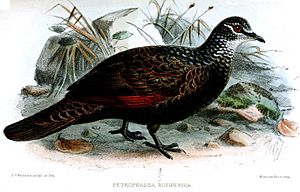Chestnut-quilled rock pigeon facts for kids
Quick facts for kids Chestnut-quilled rock pigeon |
|
|---|---|
 |
|
| Conservation status | |
| Scientific classification | |
| Genus: |
Petrophassa
|
| Species: |
rufipennis
|
The chestnut-quilled rock pigeon (Petrophassa rufipennis) is a special type of pigeon. It has a dark brown body and a bright, eye-catching chestnut (reddish-brown) patch on its wing. You can easily spot this patch when the bird is flying. This pigeon also has cool pale lines around its eyes.
It's a bird from the Columbidae family. It acts a lot like the white-quilled rock pigeon and lives in similar places. However, the chestnut-quilled rock pigeon is only found on rocky cliffs and escarpments. These areas are in western Arnhem Land, which is in the Northern Territory of Australia.
Contents
Discovering the Chestnut-quilled Rock Pigeon
The chestnut-quilled rock pigeon was first seen by a German explorer named Ludwig Leichhardt. He spotted it way back on November 11, 1845. This was near the South Alligator River in the Northern Territory of Australia. Even though he saw it, he didn't collect a specimen.
Later, in 1898, a Norwegian scientist named Robert Collett officially described this bird. He used a specimen that another explorer, Knut Dahl, had collected from the same area. Collett gave the bird its scientific name, Petrophassa rufipennis.
What Does Its Name Mean?
The common name "rock pigeon" tells you where these birds like to live. They are often found on tropical sandstone cliffs.
The scientific name, Petrophassa rufipennis, comes from ancient languages:
- Petros is a Greek word meaning "rock." This refers to its favorite rocky home.
- Phassa is another Greek word for a wild pigeon.
- Rufus is a Latin word meaning "red."
- Penna means "feather," so pennis means "winged."
So, rufipennis describes the big, reddish-brown patch on its wing.
What Does This Pigeon Look Like?
The chestnut-quilled rock pigeon is a dark, sooty brown color. It has a very noticeable bright chestnut patch on its wing. This patch is usually hidden when the wing is folded. But when the bird flies, it really stands out!
These pigeons have a wingspan (how wide their wings are stretched out) of about 138 to 155 millimeters (about 5.4 to 6.1 inches). Their bill (beak) is about 11.0 to 14.5 millimeters long. They weigh between 130 and 178 grams (about 4.6 to 6.3 ounces).
They have black areas around their eyes, called lores. They also have pale spots on their head and neck. Their chin and throat are a whitish color. You can see fine grey lines around their eyes. One line goes from above the bill and curves over and behind the eye. Another line goes from the base of the bill, passes below the eye, and goes under the ear feathers.
How Do They Behave?
You will most often see these pigeons when they are startled and fly away. They usually live in pairs or small groups on rocky ledges. When they fly, their wings make a loud clapping sound. They often fly straight up from a gorge (a narrow valley).
An explorer named Leichardt saw this typical behavior a long time ago. He wrote about how they flew out from shady rocks or from wet spots where local people had dug wells. He said they gathered around these spots like flies around syrup!
Conservation Status
The Northern Territory of Australia lists the chestnut-quilled rock pigeon's conservation status as "Near Threatened." This means they might become endangered in the future if we don't protect them.
However, the IUCN Red List, which is a global list of threatened species, says the pigeon's status is "Least Concern." This means they are not currently at high risk of extinction worldwide.
The chestnut-quilled rock pigeon shares a special way of moving and living (called a jizz) and a similar habitat with the white-quilled rock pigeon. But the chestnut-quilled rock pigeon only lives in the sandstone areas of Arnhem Land and Kakadu.
See also
 In Spanish: Paloma roquera alirrufa para niños
In Spanish: Paloma roquera alirrufa para niños


